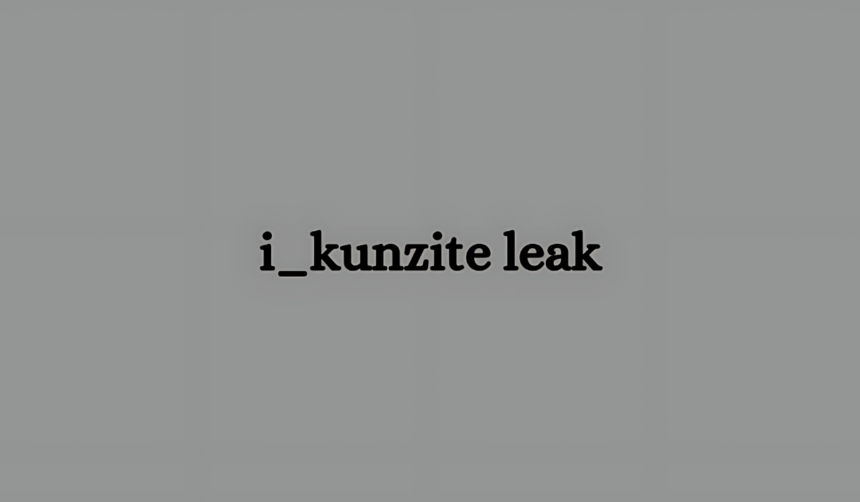SEO Meta-Description:
Discover the significant impact of the i_Kunzite Leak on data privacy and cybersecurity, and learn seven crucial lessons to protect your digital information.
Introduction
In the ever-evolving landscape of digital security, the i_Kunzite Leak has emerged as a stark reminder of the vulnerabilities inherent in our online systems. This incident, which saw sensitive information compromised, has profound implications for data privacy and cybersecurity. By examining the impact of the i_Kunzite Leak, we can glean crucial insights into safeguarding our personal and professional data against similar threats. This article delves into seven essential lessons that the i_Kunzite Leak has taught us, emphasizing the importance of robust cybersecurity measures in an increasingly interconnected world.
Understanding the i_Kunzite Leak
The i_Kunzite Leak refers to a major security breach where a significant amount of sensitive data was exposed to unauthorized parties. This incident highlighted glaring weaknesses in the affected system’s security protocols, leading to widespread concerns about data privacy and the integrity of online information. The breach involved the exposure of personal information, financial records, and other confidential data, underscoring the need for stringent cybersecurity practices.
Lesson 1: The Importance of Strong Passwords and Authentication Methods
One of the primary takeaways from the i_Kunzite Leak is the critical role of strong passwords and multi-factor authentication in protecting sensitive information. Weak or easily guessable passwords can be a major vulnerability, allowing unauthorized access to valuable data. By implementing robust authentication methods, individuals and organizations can significantly reduce the risk of data breaches.
Lesson 2: Regular Software Updates and Patches
The i_Kunzite Leak underscored the necessity of keeping software and systems up-to-date. Cybercriminals often exploit vulnerabilities in outdated software to gain unauthorized access. Regular updates and patches address these security flaws, enhancing the overall security posture of systems and preventing breaches like the i_Kunzite Leak.
Lesson 3: Employee Training and Awareness Programs
Human error is often a significant factor in data breaches. The i_Kunzite Leak highlighted the need for comprehensive employee training and awareness programs focused on cybersecurity best practices. Educating staff about phishing attacks, safe internet habits, and data protection protocols can mitigate risks and foster a culture of security within organizations.
Lesson 4: The Role of Encryption in Data Protection
Encryption is a powerful tool in the fight against data breaches. The i_Kunzite Leak emphasized the importance of encrypting sensitive data both in transit and at rest. By converting data into an unreadable format for unauthorized users, encryption ensures that even if data is intercepted, it remains secure and inaccessible to cybercriminals.
Lesson 5: Regular Security Audits and Vulnerability Assessments
Conducting regular security audits and vulnerability assessments is crucial for identifying and addressing potential weaknesses in systems. The i_Kunzite Leak serves as a reminder that proactive measures, such as penetration testing and risk assessments, can help organizations identify and rectify security gaps before they are exploited by malicious actors.
Lesson 6: Incident Response Planning and Preparedness
Having a robust incident response plan is essential for mitigating the impact of data breaches. The i_Kunzite Leak highlighted the importance of being prepared to respond swiftly and effectively to security incidents. An incident response plan outlines the steps to be taken in the event of a breach, ensuring that organizations can contain the damage, notify affected parties, and restore normal operations as quickly as possible.
Lesson 7: Collaboration and Information Sharing
The i_Kunzite Leak demonstrated the value of collaboration and information sharing among organizations and cybersecurity professionals. By sharing threat intelligence and best practices, entities can collectively enhance their security measures and better defend against common threats. This collaborative approach fosters a more resilient cybersecurity ecosystem, where knowledge and resources are pooled to combat cybercrime effectively.
The Broader Implications of the i_Kunzite Leak
Beyond the immediate lessons, the i_Kunzite Leak has broader implications for data privacy and cybersecurity. It underscores the need for a comprehensive and proactive approach to security, one that involves continuous monitoring, threat detection, and response strategies. The leak also highlights the evolving nature of cyber threats, necessitating adaptive and innovative security solutions.
How Organizations Can Protect Themselves Post i_Kunzite Leak
Organizations looking to bolster their cybersecurity in the wake of the i_Kunzite Leak should consider implementing a multi-layered security strategy. This includes:
- Adopting Zero Trust Architecture: By verifying every access request, whether from inside or outside the network, organizations can minimize the risk of unauthorized access.
- Investing in Advanced Threat Detection Tools: Utilizing AI and machine learning to identify and respond to suspicious activities in real-time.
- Implementing Data Loss Prevention (DLP) Solutions: Protecting sensitive data from being leaked, lost, or misused by monitoring and controlling data transfers.
Conclusion
The i_Kunzite Leak serves as a critical reminder of the vulnerabilities that exist within our digital infrastructure. By learning from this incident, we can take proactive steps to enhance our data privacy and cybersecurity measures. From strengthening passwords to implementing robust incident response plans, the lessons from the i_Kunzite Leak are invaluable in our ongoing efforts to protect sensitive information. As cyber threats continue to evolve, staying vigilant and adopting comprehensive security practices will be essential in safeguarding our digital lives.
FAQs
What was the i_Kunzite Leak?
The i_Kunzite Leak was a major security breach where a substantial amount of sensitive data was exposed to unauthorized parties, highlighting weaknesses in the affected system’s security protocols.
How can strong passwords prevent data breaches?
Strong passwords, combined with multi-factor authentication, make it significantly harder for cybercriminals to gain unauthorized access to accounts and sensitive information.
Why are software updates important for cybersecurity?
Regular software updates and patches fix known vulnerabilities, preventing cybercriminals from exploiting these flaws to access systems and data.
What role does employee training play in cybersecurity?
Employee training raises awareness about cyber threats and promotes best practices, reducing the likelihood of human error leading to data breaches.
How does encryption protect data?
Encryption converts data into an unreadable format for unauthorized users, ensuring that even if intercepted, the data remains secure and inaccessible.
What should be included in an incident response plan?
An incident response plan should outline the steps to be taken during a security breach, including containment, notification, and recovery procedures.
How can organizations collaborate to enhance cybersecurity?
Organizations can share threat intelligence and best practices, fostering a collaborative approach to combatting cyber threats and enhancing overall security.











Bookmarked, so I can continuously check on new posts! If you need some details about Website Traffic, you might want to take a look at Webemail24 Keep on posting!
Awesome page with genuinely good material for readers wanting to gain some useful insights on that topic! But if you want to learn more, check out QH6 about Car Purchase. Keep up the great work!